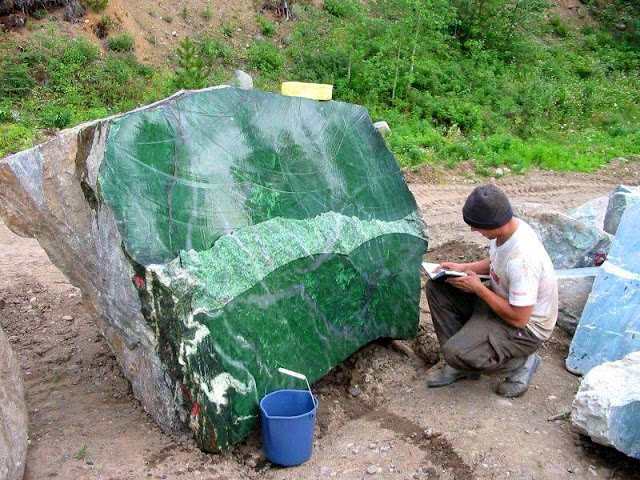Tons of Giant Nephrite Jade Discovered in Canada
In many colors jade is found in black, blue, orange, brown, cream, gold, white and lavender. The different types of jade include jadeite and nephrite.
Nephrite is tougher and harder to break than jadeite material. The Polar Pride boulder was called the find of the millennium by trade experts and was discovered in Canada. The 18-ton boulder was split in half to be used for carving.
Jade was first identified in Canada by the Chinese settlers in 1886 in British Columbia, Canada. At this time jade was considered to be worthless as they were searching for gold.

Jade was not a commercialized stone in Canada until the 1970s. Commercial mining of Canadian jade began in 1972, by two Californians who started the mining business Loex James Ltd.
There are over fifty known nephrite occurrences found in British Columbia. These occurrences are located in Southern British Columbia, the Cassiar, Cry and Dease Lake, and Mount Ogden areas.
These nephrite occurrences consist of individual blocks, talus blocks, boulder fields, and in situ occurrences. Most of the nephrite in situ occurrences are lens-shaped or cigar-shaped.

Until the 1960s, almost all of the nephrite that was produced in British Columbia came from secondary deposits. With the rapid expansion of the amateur lapidary activity after World War II, production in the jade fields of British Columbia’s picked up, and they became the most important suppliers.
Around the same time, markets opened up in the Orient and Germany. Mining activity for Nephrite gradually depleted the secondary deposits, but increasing the values of the stone led to further exploration.
These efforts uncovered primary deposits of jade adjacent to the Fraser River in southern British Columbia, the Mount Ogden area of central British Columbia and the Cassiar jade fields in the far north of the province. Today, British Columbia is the main supplier for the Chinese market of Nephrite.
Nephrite mining in the province of British Columbia is very challenging. Winters are typically long and extremely cold, and deposits of Nephrite are remote, so mining can only happen during the shorter summer season, which is only about 60 days a year.

Almost all of the secondary deposits of jade are exhausted, so current mining is almost always from primary deposits. Transporting the heavy equipment to the jade mining sites is backbreaking work.
Jade West uses its diamond-coated circular, wire saws and modern high-pressure hydraulic splitters to remove the nephrite boulders from the mountain and saw them into pieces of a manageable size.
Nephrite’s toughness makes it an extremely difficult stone to break out of the rock. While blasting the Nephrite had been used in the past, Jade West no longer uses explosives.
Nephrite deposits range in size from 12 inches to 12 feet wide. The wider deposits of jade are very challenging to the quarry.
Nephrite boulders on the surface can sometimes reach weights of about 200 tons and are rarely under 100 pounds, but Jade West tries to limit the overall weight of its jade Nephrite boulders to five tons, which is a good size for them to mine, handle, and then transport on trucks to the nearest town, which is about 100 miles away.
The average weight of Nephrite is two tons, a size that satisfies most of the carving factories in China.
